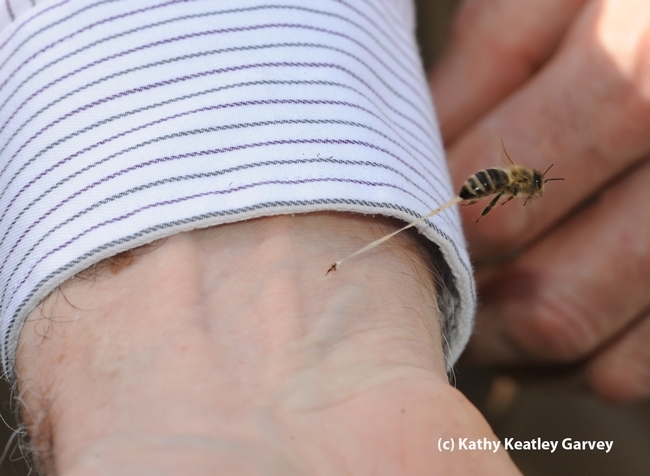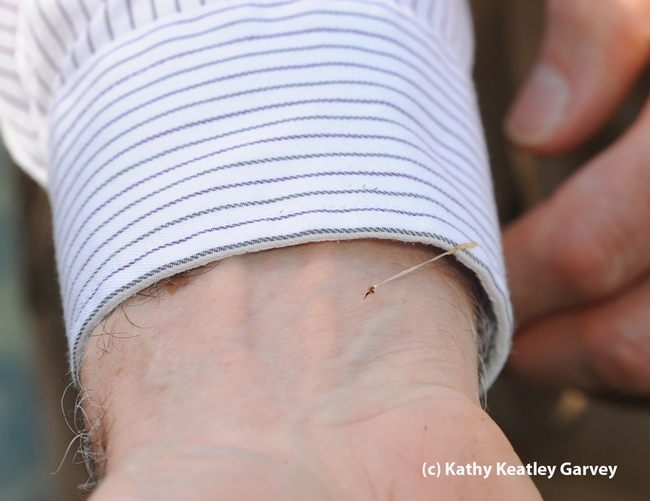
That's the question PBS Newshour asked Extension apiculturist (retired) Eric Mussen of the UC Davis Department of Entomology and Nematology for its "Just Ask" feature.
Mussen, who retired in June after 38 years of service but continues to maintain an office in Briggs Hall on the UC Davis campus, has been stung plenty of times. And the whole world knew it when this photo of "The Sting" (below) went viral.
When a bee stings, it cannot remove its barbed stinger without yanking out its abdominal tissue, aka "guts." It's basically a suicide mission in defense of its hive. Of the three castes in the colony, only the female worker bee dies when it stings. The queen can sting multiple times. The drone (male) has no stinger.
The stinger is hollow and pointed, like a hypodermic needle, Mussen told PBS Newshour reporter Anna Christiansen. The stinger, he explained, contains two rows of lancets, or saw-toothed blades.
Christianson also quoted Mark Winston, biologist and author of Bee Time: Lessons from the Hive (Harvard University Press) as saying that the blades alternate, “scissoring together into your flesh."
"It looks — and works — like a screw anchor, meaning that once in, the stinger can't retract," Christianson wrote. "Muscles connect the stinger to a venom sac, from which a cell-destroying toxin is pumped into the hole."
Mussen further explains bee stings in a UC Statewide Integrated Pest Management (UC IPM) Pest Note, Bee and Wasp Stings.
"Stingers are effective weapons because they deliver a venom that causes pain when injected into the skin," Mussen wrote. "The major chemical responsible for this is melittin; it stimulates the nerve endings of pain receptors in the skin. The result is a very uncomfortable sensation, which begins as a sharp pain that lasts a few minutes and then becomes a dull ache. Even up to a few days later, the tissue may still be sensitive to the touch."
"The body responds to stings by liberating fluid from the blood to flush venom components from the area. This causes redness and swelling at the sting site. If this isn't the first time the person has been stung by that species of insect, it is likely that the immune system will recognize the venom and enhance the disposal procedure. This can lead to very large swelling around the sting site or in a whole portion of the body. The area is quite likely to itch. Oral and topical antihistamines should help prevent or reduce the itching and swelling. Try not to rub or scratch the sting site, because microbes from the surface of the skin could be introduced into the wound, resulting in an infection."
Mussen says that nearly everyone has been stung by an insect at one time or another., and for beekeepers, it comes with the occupation. "It's an unpleasant experience that people hope not to repeat, but for most people the damage inflicted is only temporary pain," Mussen wrote. "Only a very limited portion of the population—one to two people out of 1,000—is allergic or hypersensitive to bee or wasp stings. Although this publication is about stings from bees and wasps, the information pertains to stings from fire ants as well."
He warns that it is important to remove the stinger immediately because the venom will continue to pump for 45 to 60 seconds following a sting. Mussen usually scrapes and removes the stinger with a fingernail. "Much has been written about the proper way to remove a bee stinger, but new information indicates it doesn't matter how you get it out as long as it is removed as soon as possible. Fingernails or the edge of a credit card are both effective tools. If a stinger is removed within 15 seconds of the sting, the severity of the sting is reduced."
Read more about bee stings in the PBS Newshour feature question, and in the UC IPM Pest Note, Bee and Wasp Stings.
Attached Images:

A honey bee embeds its stinger in the wrist of Eric Mussen and then tries to pull away. Note the abdominal tissue trailing. (This is an actual photo of a bee sting; it was not posed.) (Photo by Kathy Keatley Garvey)

The bee has pulled away to die, leaving the stinger and abdominal tissue behind. (Photo by Kathy Keatley Garvey)